Learning to code has never been easier than in 2022. Sites like Pluralsight and Udemy offer a huge variety of online courses you can use to learn at your own pace. But if you had to pick between Pluralsight vs Udemy, which one should it be?
Which website is better for learning to code and improving your programming skills quickly? What is the better option for beginners?
Just a few years back, I was where you are right now. I wanted to learn to code, but I had no idea where to start. The number of online courses and learning platforms just felt overwhelming.
And trust me, when you are just getting started with learning programming and web development, you can’t waste your time on poor quality courses and tutorials. You want to find the ones that really help you achieve your goals as quickly as possible.
To help you find the best, most efficient learning platform to support you, I will share my experience with this Pluralsight vs Udemy comparison post.
I will start with a glance at both platforms and then walk you through the most important differences between Udemy vs Pluralsight.
Finally, we will sum everything up to see what’s the best choice for you.
By the time you are done reading this article, you will have a good overview of their pros and cons. This should help you make a well-informed choice and learn programming and web development faster.
Let’s dive right in!
Here are a couple of related articles you may find helpful, too:
- What Programming Language Should I Learn? Beginner’s Guide
- The Best Way to Learn to Code: Step-by-Step Guide
Please note: This post contains affiliate links to products I use and recommend. I may receive a small commission if you purchase through one of my links, at no additional cost to you. Thank you for your support!
Why use Pluralsight and Udemy for learning to code?
If you’re learning to code online, I’m sure you have heard about Udemy and Pluralsight. I use both of them parallel to brush up my web dev skills, too.
I’ve been using Udemy since 2016 and Pluralsight since 2018, so it’s a good time to sum up my thoughts about the two. I spend time on both platforms every day and I’m often asked about their differences.
Their biggest benefit is that they offer courses where you can learn at your own pace. Hence, if you can’t commit to a regular, daily learning routine, both Pluralsight and Udemy offer a flexible means of achieving your goals.
Moreover, both platforms are beginner-friendly. If you’re 100% new to programming, you can find high-quality courses to learn to code from absolute scratch on both platforms.
Read also: 10 Essential Reasons to Start an Online Coding Course Now

Should you pay for an online coding course?
But what about the price? Both Udemy and Pluralsight offer paid courses. Should you spend money on learning how to code?
Here’s the deal:
Although you can find endless learning resources for learning to code online, paid courses usually offer higher quality.
Especially if you’re a beginner, you’ll probably be better off with a guided, professional course. After all, course instructors have an incentive to produce high-quality courses if they get paid for it, right?
In short, you really do get what you pay for.
However, this is something I can’t emphasize enough:
Before purchasing a course, make sure it’ll really help you achieve your long-term goals. Think about:
- What you want to create with your tech skills
- Where you want to work
- What tools you need to learn to get there
Then, try a few free resources and coding tutorials first and see if you like learning about the topic to begin with.
But back to Pluralsight vs Udemy now. How exactly are they different? Which one should you use to learn to code from scratch? What platform is going to help you achieve you coding goals the fastest?
At a glance: Udemy vs Pluralsight comparison
If you’re new to coding, both Udemy and Pluralsight are great places to start your learning journey.
Of course, there are other awesome websites for learning to code out there, too, but these two are among the most popular ones and I’ve had a great time learning with them both this year.
Let’s take a brief glance at both platforms to get an overview of how they work.
Udemy

Udemy is an online learning platform with the biggest selection of courses worldwide. Their catalog comprises over 100,000 courses in just about any topic you can imagine.
If you’re new to coding and web development, Udemy is a great place to find beginner-level courses to start learning.
If you know exactly what skills you want to learn, things will be even easier. In case you’re not sure what to specialize in, I’d suggest you pick a coding or web development course that introduces you to multiple popular tools.
For example, The Complete Web Developer Course 2.0 will help you figure out which ones you enjoy working with the most.
What’s great about Udemy is their review and rating system. You’ll find it easy to spot the most popular courses on any topic and to read through the reviews. This helps you find a high-quality course on any topic quickly.
Also, since top-rated courses sell better, course instructors have an incentive to produce top-quality content.
Pros:
- Huge selection of over 100,000 courses on any topic you can imagine
- Courses available in several languages
- Transparent review and rating system
- Pricing based on individual courses
- Frequent flash sales
Cons:
- Course quality varies a lot
- Courses cost up to $300
Read also: Udemy Review: How to Learn Programming Online From Scratch
Pluralsight

Pluralsight offers a wide selection of about 7,000 online courses for both beginners and advanced-level developers in creative and technical topics.
What Pluralsight lacks in quantity compared to Udemy, it makes up for in quality, though.
The best part?
You can learn a specific skill from start to finish with a Pluralsight learning path. They consist of individual courses in the right order for a steeper learning curve. Thus, you’ll always have a cohesive learning experience without having to worry about missing something.
Although their course catalog is comparatively narrow, it often offers more in-depth content than Udemy. Each course is carefully planned and produced in cooperation with leading industry experts.
If you’re serious about acquiring valuable new skills and becoming a master in coding and web development, Pluralsight is a great place to start. You’ll have 24/7 support to help you with your questions, too.
Pros:
- High-quality, professional-level courses
- Cohesive and consistent quality content
- Comprehensive learning paths for a guided learning experience
Cons:
- Courses have a comparatively narrow focus on technology and business
- Subscription-based pricing: you can’t purchase individual courses
Differences between Pluralsight vs Udemy
Now that you know the basics of both Pluralsight and Udemy, let’s look at their differences in more detail.
These are the most important points on Pluralsight vs Udemy you should consider:
- Pricing model
- Costs and plans
- Course topic variety
- Content quality
- Community interaction and support
Let’s start by looking at the differences in pricing for Pluralsight vs Udemy:
1: Pricing model
The main difference between Udemy and Pluralsight is their pricing model. Depending on how much time and effort you’re willing to invest in your learning journey, you can pick a model that suits your budget.
Udemy pricing model
Udemy is a marketplace where anyone can produce and sell their courses on any topic they choose. Thus, you pay for each course separately.
When you purchase a course, you gain lifetime access to the course content and it’s yours to keep forever. This is a huge advantage because you can always come back to the course material for revision.
Also, if you get stuck or need to take a break from learning, you don’t have to worry about deadlines. Therefore, I use most Udemy courses and projects as reference material for my work these days.
Furthermore, course instructors may add new course modules anytime. So, even if you’ve finished your course, you can always come back and see what’s new.
Pluralsight pricing model
Pluralsight works on a subscription-based pricing model. You sign up for a subscription plan and pay a monthly fee to gain access to their entire learning platform.
At the moment, their library contains a whopping 7,000+ courses for you to choose from.
So, which pricing model works better for you?
In general, if you can invest a lot of time for learning every week, Pluralsight may be a better option for you. Hence, the more you learn in a short period of time, the higher the return on your investment will be with the subscription-based model.
On the other hand, Udemy is better if you plan on learning the basics of coding and you’re not sure how long you need. Udemy gives you lifetime access to each course, so you’re not in a hurry.
2: Costs and plans
Udemy
You can find tons of free beginner-level courses on Udemy. However, if you want to learn something more in-depth and make sure the content is up-to-date, you should invest a few bucks in a high-quality course.
Now, we’re not talking about a huge investment here. The course prices on Udemy vary roughly between $0–$200.
However, Udemy often offers flash promotions where they put all courses on sale for $10–$15:
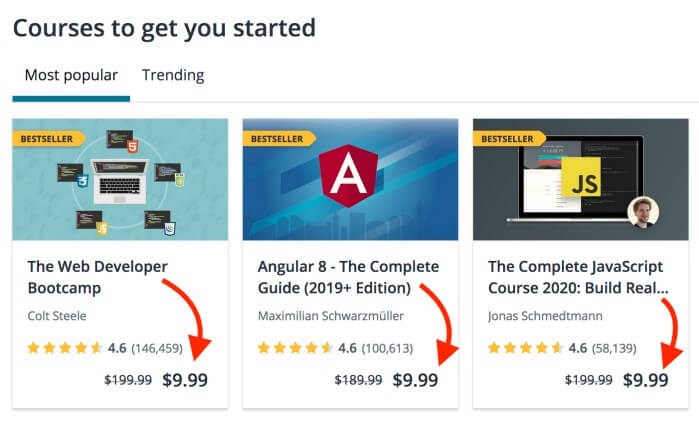
These deals are great value for your money, considering a single course may teach you everything you need to know to start making money with your programming skills.
To be honest, I’ve never spent more than $15 on a Udemy course. In fact, I’ve purchased a number of helpful courses just because of a promo. And knowing I’ll have lifetime access means I’m not in a hurry to finish them.
Pluralsight
Pluralsight offers two different plans for their paid subscriptions:
- Standard plan: $29 per month (or $299 per year)
- Premium plan: $45 per month (or $449 per year)

Thus, depending on how much time you can dedicate to learning, you can choose a package that fits your budget.
Again, the more you plan to learn in a short period of time, the higher your ROI will be with Pluralsight.
Also, keep in mind that Pluralsight sometimes offers promotions with discounts of up to 30–40% a few times a year, usually around holidays.
If you want to try Pluralsight for free, try their 10-day trial to get a taste of what they offer.
3: Course topic variety
Udemy
Udemy currently offers about 183,000 online courses, claiming to have the largest selection of courses worldwide.
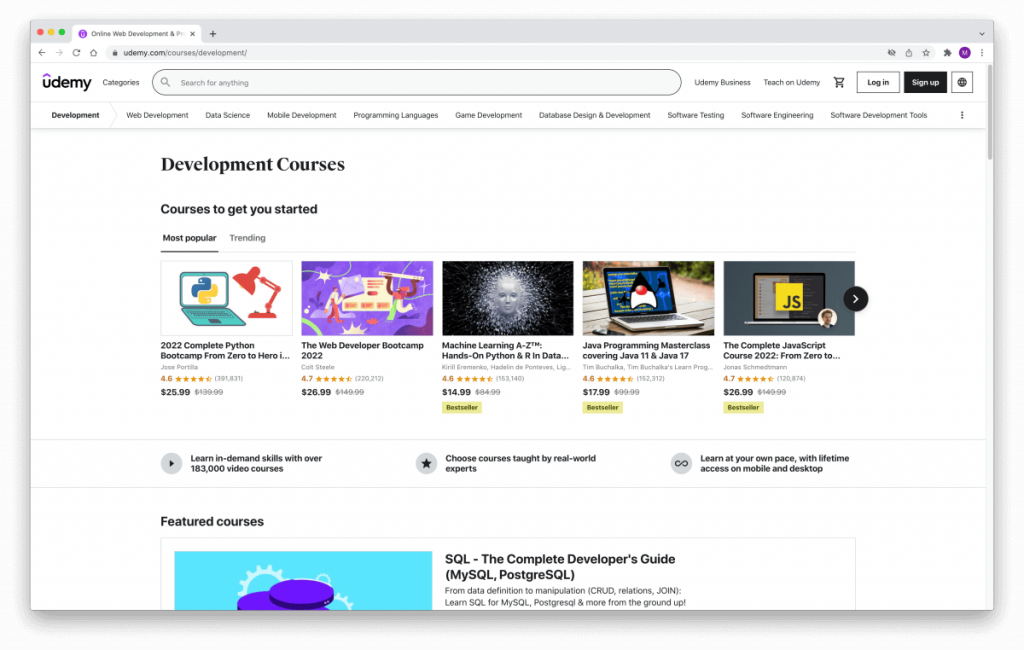
What’s great about their catalog is that you can often find courses in your own language, too. So, if English isn’t your first language, don’t worry! Head over to the footer and select your language from the menu:
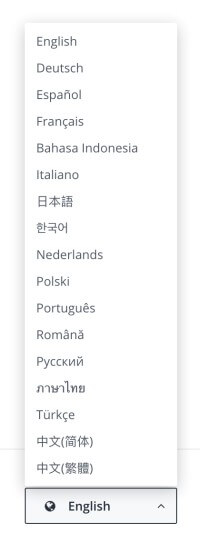
Can’t see your language here? No worries! Course instructors can upload their courses in any language they choose. So, just search for a course in your language and see what you can find.
The sheer number of courses can sometimes feel overwhelming – but inspirational, too. If you have a hobby you’d like to learn more about, just wait for the next flash sale. Apart from web development, I’ve tried courses in Spanish, for example. Ay que bueno!
Pluralsight
Pluralsight offers a range of about 7,000 online courses in their catalog. Their course topics are focused almost purely on tech, including web development, software development, and game development.
However, they also offer a few basic courses for more creative topics such as graphic design and 3D modeling, too.
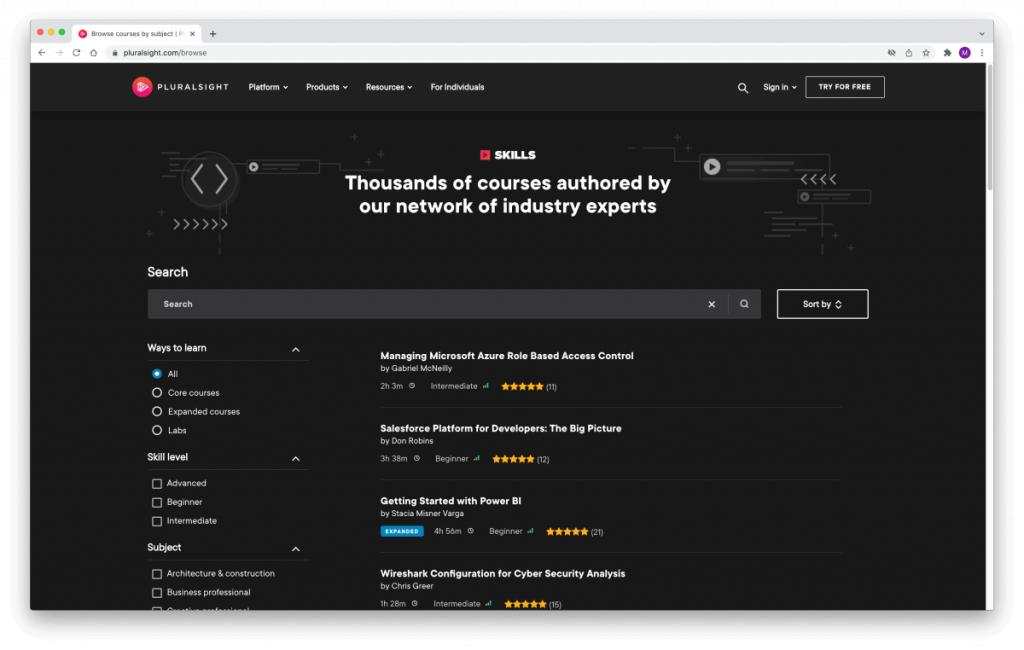
Since the course library is more focused than on Udemy, it’s easy to find courses that complement each other. Thus, you can quickly combine a handful of courses to learn a specific skill from start to finish.
However, one of my favorite features with Pluralsight are their various learning paths.
The paths are tailor-made packages with multiple courses that support each other. Each path helps you learn a specific skill – from zero to hero – without having to worry about missing something or going through repetitive content between courses.
Clearly, Pluralsight has a team working tirelessly to ensure the quality of their courses remains at a certain level. Let’s look at course quality in more detail next.
4: Content quality
When it comes to course quality with Pluralsight vs Udemy, it’s a tricky thing, really.
The biggest challenge with learning programming and web development is to keep learning constantly. If you want to start a developer career or become a freelance web developer, you need to keep your skills up-to-date.
That said, be prepared to learn a lot – and never stop learning.
Hence, look for a learning platform that offers up-to-date courses with relevant content about the latest developments in the industry.
Course quality on Udemy
On Udemy, anyone can upload a course on a topic they want to teach others about. Thus, the quality varies a lot even within a single niche.
Now, what’s great about Udemy is their ranking and review system. Each student can review and rate a course, which results in an overall rating. The more reviews and the higher the rating, the more popular the course will become. Makes sense, right?
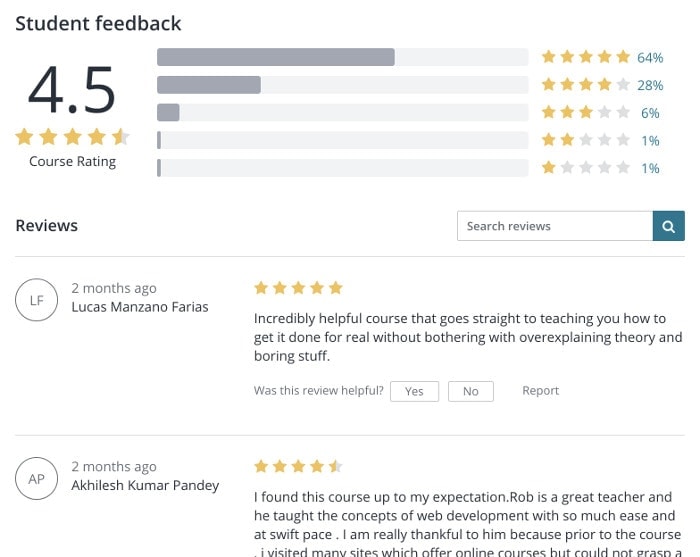
Thus, in order to keep their courses top-rated to generate more sales, course instructors have a direct incentive to keep their content up-to-date.
With that being said, make sure you always pay attention to course ratings and reviews before purchasing it.
Content quality on Pluralsight
When it comes to content quality, Pluralsight is quite different. They are very selective about their authors and what content they can produce.
Hence, they use experienced industry experts to plan and produce their courses. Needless to say, the quality is top-notch and professional, both in terms of production quality as well as the content itself.
Pluralsight has a similar reviewing system in place as Udemy, but there’s no incentive for them to update their courses as frequently. I’ve seen quite a bit of outdated, obsolete content lately, browsing through their library.
However, they’ve always been responsive to any feedback and questions I’ve had about something that felt a tad outdated.
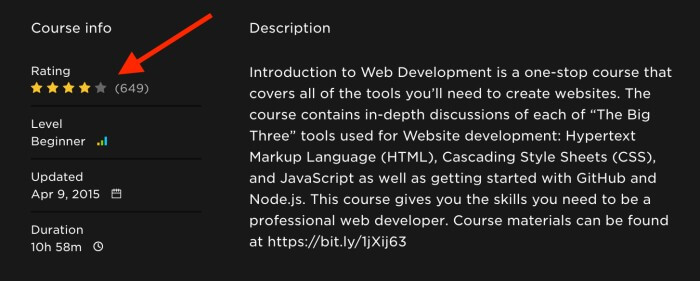
Overall, Udemy has done a better job at using course popularity as an incentive for the instructors to keep their stuff updated and relevant.
But where Pluralsight gets the full score is their production quality. All their videos, audio, images and screenshots are super crisp and easy on the eyes and ears.
5: Community interaction and support
The last thing we’ll look at is how easy it is to find help and connect with other students.
Udemy
Udemy has built a few helpful tools for connecting with your fellow students right into their system.
As you’d expect, each course has its own discussion forum. It’s the easiest way to find helpful tips and answer questions from others.
Another great feature is built into the video lectures. If you ever get stuck while you’re watching a video, you’ll find a Q&A section directly below the video:
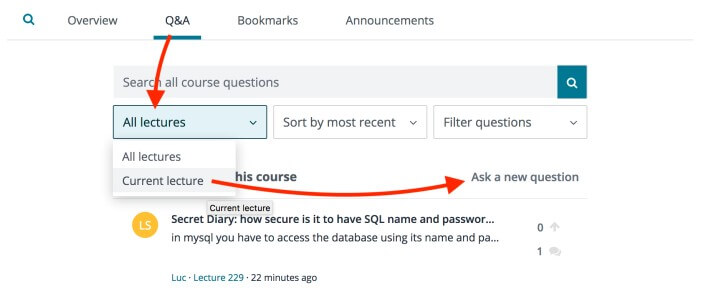
This feature is super helpful for those moments when you feel like you’re stuck.
Pluralsight
Pluralsight only offers a course-level discussion forum for their students. So, if you have a question about a specific module or lecture, it’s not as easy to address your issue as it is with Udemy.
Summing it up: Pluralsight vs Udemy comparison
So, there you have it! Both Udemy and Pluralsight are great platforms for beginners and they deliver high-quality courses.
Thus, when it comes to choosing between Pluralsight vs Udemy, it is all about being mindful about what your goals are and how much time and effort you’re willing to put into your learning process.
I use and love both of them and they have definitely been worth the investment. I have seen quick results by using them individually and by combining their resources to complement one another.
Let’s do a short recap:
When to choose Udemy:
All in all, Udemy is better if you’re looking to learn the fundamental basics of coding and web development. Their courses are often easier for absolute beginners with somewhat better tools for connecting with like-minded students.
When it comes to the price, Udemy is more flexible and requires less commitment. You can wait until a promotion comes along and invest $10 in your first online coding course. If it isn’t what you expected, you’ll still have access to the course for the rest of your life.
To help you out, I’ve put together a few topics that you might find interesting. Here are the top courses on Udemy to get you started:
- HTML and CSS Courses on Udemy
- JavaScript Courses on Udemy
- Python Courses on Udemy
- PHP Courses on Udemy
When to choose Pluralsight:
On the other hand, if you’re looking for professional-level development, Pluralsight is by far the better option. If you can commit to spending time to follow through an entire learning path from start to finish, their courses deliver great results quickly.
However, the subscription based pricing on Pluralsight is a tad more expensive than Udemy, but the content quality is superb. Whatever course you pick, you can always be sure that everything will be up to standards.
If you haven’t already, make sure you check out Pluralsight’s free trial to test their platform hands-on and risk-free.
Are you planning to use either Pluralsight or Udemy to learn new tech skills? Which one are you going to choose? Let me know in the comments below!
If neither Udemy nor Pluralsight is the right platform for you, check out my full guide on the best Udemy alternatives, too.
Here are a few helpful posts you may want to read, too:
- 7 Smart Tips: How to Get Your Money’s Worth With Online Coding Courses
- 10 Easy Tips for Learning to Code Faster
If you enjoyed this post on Pluralsight vs Udemy, make sure to drop me a line in the comments section!
P.S. Please share this post with others so that they can find it, too! Thanks so much for your support!
Happy coding!
– Mikke

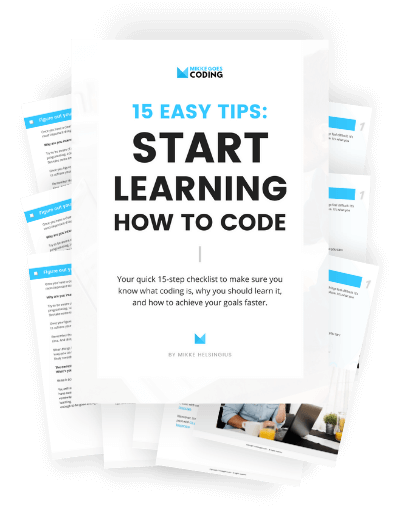
I bought several Udemy courses over the years. The company I work for now subscribes to Pluralsight. Both platform should tell you to set up your own test environment for whatever you are attempting to learn as just watching videos can be boring and not get you very far. Both should also include definite break points (places to pause so you can actually code the material just presented). I know you can pause but that, changes the flow of the lesson. The best course I took which offered a lot of interactivity was a “Grow with Google” Google IT Support Professional Specialization certification course through Coursera. It was an eight month course which I got done in a little over two months. It offered the first week free and then it was $49.00 USD per month. There were video lectures, quizzes and lab exercises to test you knowledge of the material presented. The cloud based lab exercises set this apart from Udemy and Pluralsight. I wish those platforms would offer something similar. I am currently taking training from the Linux Training Academy and their training seems a little closer to Coursera’s in that they help you setup a Virtual Machine to practice with. As I get deeper in to the courses through Linux Training Academy I will try to post an update.